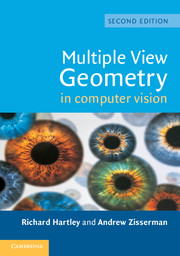Book contents
- Frontmatter
- Contents
- Foreword
- Preface
- 1 Introduction – a Tour of Multiple View Geometry
- PART 0 The Background: Projective Geometry, Transformations and Estimation
- PART I Camera Geometry and Single View Geometry
- 6 Camera Models
- 7 Computation of the Camera Matrix P
- 8 More Single View Geometry
- PART II Two-View Geometry
- PART III Three-View Geometry
- PART IV N-View Geometry
- PART V Appendices
- Bibliography
- Index
8 - More Single View Geometry
Published online by Cambridge University Press: 25 January 2011
- Frontmatter
- Contents
- Foreword
- Preface
- 1 Introduction – a Tour of Multiple View Geometry
- PART 0 The Background: Projective Geometry, Transformations and Estimation
- PART I Camera Geometry and Single View Geometry
- 6 Camera Models
- 7 Computation of the Camera Matrix P
- 8 More Single View Geometry
- PART II Two-View Geometry
- PART III Three-View Geometry
- PART IV N-View Geometry
- PART V Appendices
- Bibliography
- Index
Summary
Chapter 6 introduced the projection matrix as the model for the action of a camera on points. This chapter describes the link between other 3D entities and their images under perspective projection. These entities include planes, lines, conics and quadrics; and we develop their forward and back-projection properties.
The camera is dissected further, and reduced to its centre point and image plane. Two properties are established: images acquired by cameras with the same centre are related by a plane projective transformation; and images of entities on the plane at infinity, π∞, do not depend on camera position, only on camera rotation and internal parameters, K.
The images of entities (points, lines, conics) on π∞ are of particular importance. It will be seen that the image of a point on π∞ is a vanishing point, and the image of a line on π∞ a vanishing line; their images depend on both K and camera rotation. However, the image of the absolute conic, ω, depends only on K; it is unaffected by the camera's rotation. The conic ω is intimately connected with camera calibration, K, and the relation ω = (KKT)−1 is established. It follows that ω defines the angle between rays back-projected from image points.
These properties enable camera relative rotation to be computed from vanishing points independently of camera position. Further, since K enables the angle between rays to be computed from image points, in turn K may be computed from the known angle between rays.
Information
- Type
- Chapter
- Information
- Multiple View Geometry in Computer Vision , pp. 195 - 236Publisher: Cambridge University PressPrint publication year: 2004
